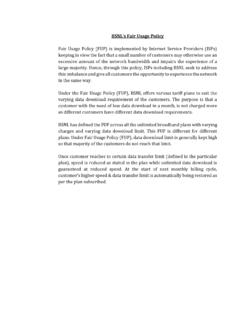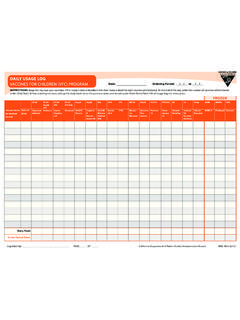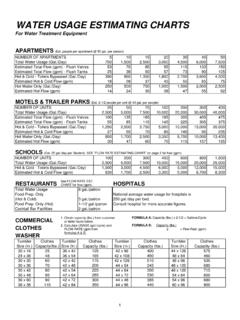Transcription of Persona Creation and Usage Toolkit - interaction by design
1 Persona Creation and Usage Toolkit George Olsen 30 March 2004. Overview This Toolkit provides resources for a variety of situations. Pick and choose what's appropriate for your's. My goal is to enable you to use personas in several ways: Allow you and your team to live and breathe your users' world as if they were a close friend or part of the family. Allow you as a designer to filter out your own personal quirks (or those of real users that you interviewed) and focus instead on behaviors and motivations that are typical of a broader range of users, while still being able to relate to users as individuals. Use this knowledge to make better decisions at the strategic level of matching the product's focus and purpose to users needs and goals. Use this knowledge to make better design decisions at the tactical level of how functionality, content and sensory elements are structured and presented. Use it as a tool to make the design trade-offs that are inevitable in any product's development.
2 To achieve these goals, the Toolkit enables you to build up detailed profiles of the personas themselves, their relationship to the product, and the context in which they use the product. The intended user of the Toolkit is the product's designer, so it's it advisable to streamline the personas to critical aspects when presenting them outside the product development team. Even within the development team, not everyone may need every single detail about the Persona . When developing personas, precision is more important than absolute accuracy for many aspects at least for the first two uses. For the latter three, it's often important to be more accurate about things related to the behavioral interaction with the product. But if necessary, it's better to take a best guess than omit something important. Note: When I refer to product, this could be a Website, software application, physical product or service. Note: This is a work in progress, since it's a tool I've built in response to various projects over the years.
3 If you have suggestions on how to improve it, please let me know. Thanks to Robert Reinman for his excellent descriptions of the first two ways of using personas. Posting on the interaction Designers Discussion mailing list 02 February 2004. Sources for Persona -building Information Ideally, personas should be based on interviewing and direct observation of users. But you may also get useful information from these alternate sources, which can also be used when contact with users isn't possible. However, handle information from these sources with extreme care it's not the same thing as dealing directly with users. User Surrogates Domain experts Can often identify what might be valuable to users, how users might do a particular task, etc. Trainers If they're having trouble teaching it, it's probably the product's fault. Immediate supervisors (for internal applications) You'll need to find out about how much they actually hear from their employees about the task or product in question.
4 In the best case, they may have a broader view of issues with the product that complements that of individual users. Informants and Interpreters Marketing Usually better at understanding a product's functional or brand issues than user experience issues. Sales The best sales people can be quite helpful since they work hard to understand customer needs, but sales people tend to have a more features are better mentality that needs to be taken into account. Also, customers may not be the people who actually use the product. Customer/Technical Support Often overlooked, but every day they hear about where the product has problems. Documentation specialists If they've had difficulty communicating how to use the product, there's probably a trouble spot. Personas Creation / Usage Toolkit Page 1 of 18 Copywrite 2004 George Olsen Indirect Sources Manuals Look for where the instructions fail to match how the work actually gets done. Look for user-created cheat sheets a sure sign of problems.
5 Derived data Gotten from records or info collected for other purposes. Traffic logs Tech support/help desk logs Customer feedback forms Artifacts Items that users create or use as part of what they're doing look for things that indicate the reveal the assumptions, concepts, strategies and structures of the artifact itself that guide the people using them. Questionnaires, surveys, focus groups, etc. Be sure to pay close attention to how the questions are posed. Also, group dynamics can seriously distort focus groups. Ersatz Users Handle with care, because they often don't know as much as they think they do. Buyers those who sign checks but don't actually use the product Upper-level managers Often they need to be listened to, but they frequently know less about customers or internal processes than they think they do. In fact, a Product Development and Management Association study on product development best practices found senior executives backed product launch failures more than half the time.
6 Based on Software from Use, Larry L. Constantine and Lucy Lockwood, 1998 Pgs. 70-77. and Contextual design , Hugh Beyer & Karen Holtzblatt, 1997, Pgs. 102-105. Persona Types Personas should be prioritized as one of the following: Focal Primary users of the product who are its main focus. We will optimize the design for them. At least one Persona must be a focal Persona . Secondary Also use the product. We will satisfy them when we can. Unimportant Low-priority users, including infrequent, unauthorized or unskilled users, as well as those who misuse the product. Affected They don't use the product themselves, but are affected by it (for example, someone who gets reports from a user of a application, or the spouse of someone using a travel Website to plan a trip). Exclusionary Someone we're not designing for. It's often useful to specify this to prevent non- users from creeping back into product development discussions. It's critical to get team consensus about the relative priority of the personas.
7 As discussed in Alan Cooper's The Inmates are Running the Asylum, if you have more than three focal personas, the design problem is too big. You probably need to split the product into more than one product or overall interface to avoid overwhelming users with too much complexity and causing the product to lose a clear focus. (For example, you can create one interface for users of a system and a different interface for those who maintain the system.). It may not be immediately obvious at first which personas are focal ones, so the Toolkit identifies characteristics that may be useful in prioritization. However, it's often critical to consider which personas are the neediest that's to say, if you can solve a design problem for them, you solve it for your other important personas. If this is the case, neediness should take priority because personas are a design tool, not a market segmentation. The flip side to neediness is looking at which users are most demanding.
8 While this runs the risk of tilting toward power users, it's not uncommon for consumer-facing products to have 20 percent of customers account for 80 percent of profits and therefore it makes sense to remember their needs. But the principle is the same as designing for the neediest users: if you can satisfy a design problem for the most demanding users then you satisfy a much larger group of users. So demanding can be a valuable complement to neediness, but should be used with care. While personas are typically created only for users of a product, it's important to keep in mind the interests of other stakeholders, who can include: Personas Creation / Usage Toolkit Page 2 of 18 Copywrite 2004 George Olsen Immediate business sponsors Higher-level management The marketing team The sales team The engineering team The customer support team The legal team Industry analysts Market/industry influencers Regulators Advertisers Suppliers Business partners Unions Public interest or lobbying groups Typically, we don't create personas for these stakeholders, however sometimes it may be useful to create minimal personas for one or more of them usually focusing on their goals to make sure their interests are taken into account.
9 At a minimum, it is often worth noting for each stakeholder: Their goals The amount of influence they have in the project The amount of knowledge they need to participate The degree of involvement they will have What conflicts they may have with other stakeholders Getting awareness and preferably team consensus about these factors can be invaluable in managing the inevitable politics around a product's development. Note: See The Inmates are Running the Asylum, Alan Cooper, 1999. for a discussion of Persona prioritization and examples. Persona 's Biographic Background All personas should be named and have accompanying photos to help humanize them. This section focuses on defining who they are and serves two purposes. First, to match personas to market segments, if appropriate. Second, to provide back story that may not be essential for design purposes but help the Persona feel more real. This background information often can come from Marketing.
10 While this sort of demographic and psychographic information may be useful from a marketing standpoint especially to ensure than consumer-facing products are appealing for designers of interactive products it's the behaviorial aspects related to the product's interactions (to be discussed later) that are most critical in making personas an effective design tool. So you should be careful not to let these characteristics divert attention from others that are more useful tools for design . Name Photo Geographic profile Can be useful if the product will be used in specific regions. May also be useful for providing non-essential details that help humanize personas. World region or country For example: North America, United States, etc. Mostly useful for when multiple countries or regions need to be served by the product. Country region Pacific Coast, Midwest This and the next two factors may be useful in understanding cultural factors, how users live their lives City/metropolitan size Under 5,000, 5,000-20,000, 20,000-50,000, 50,000-100,000, 100,000- 250,000, 250,000-500,000, 500,000-1 million, 1 million-4 million, more than 4 million Urbanicity Urban, suburban, rural Climate Sunbelt vs.




